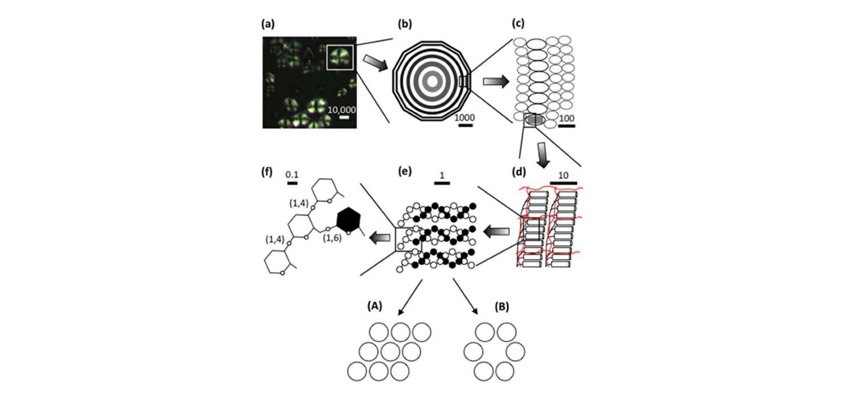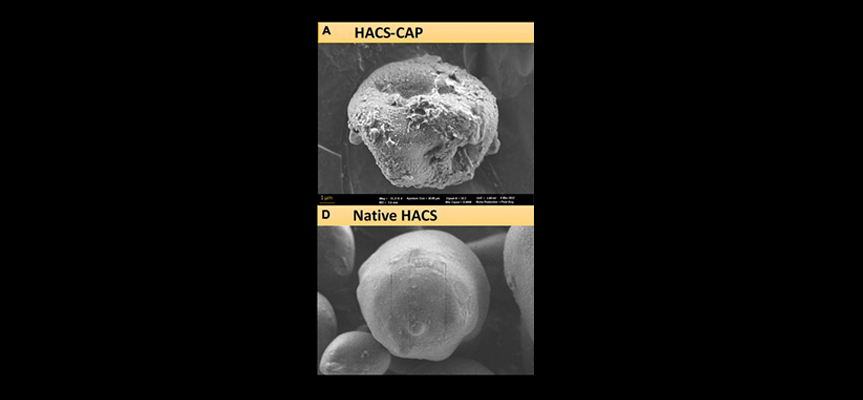Starch Structure
In starch, glucose units form a chain to create the amylose molecule. When side chains form on the main chain, amylopectin is created. The arrangement of these two molecules, in the form of amylopectin crystalline blocks and double helices of amylose in the intercrystalline space, results in a structure known as a granule. Starch granules, depending on the plant species, vary in shape and structure, which ultimately has a significant impact on the starch’s functional properties. One of the main differences between types of starch is the amylose content or the amylose-to-amylopectin ratio. Starch with low amylose content is known as waxy starch, while starch with over 50% amylose is called high amylose starch.
High Amylose Starch
High-amylose starch is less known compared to waxy and regular starches. This type of starch, due to its lower amylopectin content (the main structural component of starch crystals), forms a different crystalline structure compared to the other two types of starch from the same plant. Additionally, the thermal properties of high-amylose starch are higher due to the high melting point of amylose crystals.

Gelatinization of High Amylose Starch
Unlike regular and waxy starches, high amylose starch does not gelatinize at boiling water temperatures and requires high temperatures to break down the crystalline structure and release the molecules. Such temperatures are available in pressurized equipment, sterilization devices, and extrusion processes. Therefore, in most food production processes, this type of starch maintains its crystalline structure or gelatinizes only to a small extent. This results in minimal swelling and limited ability to increase viscosity. To utilize its gelling and retrogradation properties, sufficient thermal processing must be applied to the starch suspension.
Resistant Starch
The high gelatinization temperature of this type of starch allows it to maintain its crystalline and amylose double helix structures in most food products, enabling it to pass through the stomach and intestines and reach the probiotics in the digestive system. In fact, starch-degrading enzymes in the human intestine are unable to digest starch in this configuration. This makes resistant starch an industrially applicable component.
Retrogradation
Amylose molecules have the highest tendency to retrograde. When the temperature drops below approximately 60°C, double helices of this molecule form, and the aggregation of these helices leads to the development of a gel-like structure. Therefore, the gelatinized form of this starch retrogrades rapidly at room temperature. However, this property is valuable for the production of edible films, coatings, and encapsulation processes.
Applications
One of the applications of high amylose starch is increasing resistant starch content in the food without adversely affecting the texture and sensory characteristics of the product. Due to its high gelatinization temperature, this starch maintains its natural form in most food processing steps and exhibits resistant starch properties.
Given its high amylose content, this starch is ideal for forming edible films and coatings. Extensive research has been conducted to improve the characteristics of these films, such as enhancing their tensile strength and moisture barrier properties. By gelatinizing high amylose starch at high temperatures and then cooling it at temperatures above its gel setting point, film formation and layering are possible.
Another application of this starch is as a coating agent for compounds sensitive to stomach and intestinal conditions. Due to the amylose double helix’s resistance to intestinal enzymes, sensitive compounds are mixed into the gel-like structure formed by gelatinizing high amylose starch, followed by encapsulation through mechanical processes such as ultrasonication. Upon cooling the particles and promoting retrogradation, resistant particles are formed. These particles can then be converted into powder through various techniques like spray drying. Furthermore, this type of starch is used in the production of fibers created through electrospinning due to its resistance to digestion. Chemical modifications, such as applying hydrophobic groups to high

